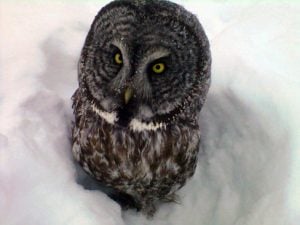Despite being Manitoba’s official bird, the great grey owl can be found in nearly every Canadian province and territory.
Fast Facts
Common name: Great grey owl
Scientific name: Strix nebulosa
Type: bird
Diet: carnivore
Group name: Parliament
Average weight: 1.1 kilograms
Wingspan: 1.3 metres
COSEWIC Status: Not at risk
Did you know?
The great grey owl is the largest owl in North America, however, the owl’s size is partly an illusion as the bird’s feathers account for most of it’s size.
Physical characteristics and behaviour
The great grey owl’s face is a distinctive flat disk of feathers used to direct sound into their ears. Whereas the rest of the owl’s body tends to be a mottled gray-brown, the disk of feathers is a brighter gray with white patches on the chin and near the eyes. Those eyes have evolved to help the owl hunt; they’re fixed in place and allow for detailed long-distance vision. The trade-off is that the owls tend to have very poor close-range vision. To help compensate for that poor close vision, the owls have a collection of sensitive feathers called crines around their beak. Those feathers help the night hunters locate dead prey.
Despite the often snowy conditions under which the owls hunt, their hearing is so good that the birds can detect the heartbeat of a rodent through several feet of snow.
The wings of the owl are serrated which allows wind to pass through silently. This helps prevent prey from catching on to the owl’s location and allows owls to hear their prey above the sound of their own beating wings.
It’s a myth that owls can turn their heard all the way around. But, thanks to extra bones in the owl’s neck (14 versus the usual seven for vertebrates), the owl can rotate its head 270 degrees from side to side, and 90 degrees up and down.
Diet
The owl feeds mostly on small mammals, including voles and pocket gophers. They’ll also eat mice, shrews, squirrels, weasels, small birds, and even frogs.
Habitat and distribution
Great grey owls can be found in country spaces with a mix of dense forest areas for nesting and open spaces for hunting. In northern spots in Canada, the owls can be found around bogs, clearings, and burn zones in large coniferous woods. In western Canada, they’re most likely to hang about in meadows in mountain forests.





